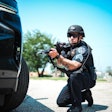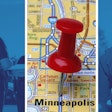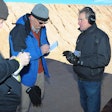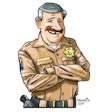Until recently very few academic researchers concerned themselves with what happened to police officers during shootings. And those who did had their research buried in peer-reviewed journals that were rarely seen by the men and women on the front lines of law enforcement. That was before Dr. Bill Lewinski co-founded the Force Science Institute at Minnesota's Mankato State University.
Since 2004, Lewinski and his team of researchers, law enforcement officers, and other colleagues have dedicated themselves not only to researching human performance factors under stress and fear but also disseminating the research of other academics to rank-and-file officers.
Lewinski was a clinical psychologist in Manitoba when he first became involved with law enforcement operations. He was called in to help with a hostage situation involving a psychopathic paranoid. An officer was killed, two others were wounded, and Lewinski wanted to help prevent such tragedies in the future. "I knew then that my days of doing therapy were over," Lewinski says.
Lewinski has focused his research on officer-involved shootings, the dynamics of the incidents, the way that stress alters the memories of the officers involved, and how officers make life-and-death decisions. His research has shed light on edged-weapon attacks, how movement in a gunfight leads to suspects being shot in the back, why officers give meaningless commands under stress, how emotion affects perception, and hundreds of other topics.
Today, Professor Lewinski's students are officers and administrators who attend his Force Science seminars. And on March 31 from 8 a.m. to 12 p.m., he will present the keynote address at POLICE-TREXPO West in Long Beach, Calif. on the telephone after he had finished a long day of seminars in San Jose, Calif.
What do officers least understand about officer-involved shootings? And what is the source of all the confusion?
With officers and departments you have to look at where they get their training about how people are going to perform [in officer-involved shootings]. They either get it through stories from fellow officers or from Hollywood. They hear what happens from fellow officers, and they hear it in classroom instructions. But for the most part, there's a lot of training about officer-involved shootings from Hollywood.
Your research is academic in nature. Is it really relevant to the street officer? And do the researchers need to do more to get this information to the officers?
There's a whole realm of performance psychology that is kind of missing in police training today. Some officers are extremely well-trained, but the issue of the science of human dynamics within the middle of a high-stress encounter is something that most officers really haven't looked at.
Many do not look at the research we do in the university, particularly the psychology and the science of human performance. And most universities...if they're doing research at all in criminal justice, it is in the area of criminal justice. It's not in kinesiology or psychophysiology, it's in the area of administration, it's in the area of community relations. And there's almost no, certainly very little, research on the dynamics of human performance, particularly connected to the line officer. So that's a bridge that never gets connected to either the university or the officer.
Your e-newsletter, Force Science News, is like a digest of research going from academia to the rank-and-file officers. What spurred you to publish it?
Back in the mid 1980s, while I was on the road with Calibre Press and their Street Survival seminar, I came across a firearms instructor who attempted to testify in court on tunnel vision and tunnel hearing. And the judge said there wasn't any research on those. Several police psychologists like Kevin Gilmartin (author of "Emotional Survival for Law Enforcement") had written articles in police magazines on those, but there wasn't any academic research, according to the judge.
But the judge was wrong. Thirty years before, there were three journals whose primary focus was the effect of emotion on perception and one of those journals focused entirely on the effect of emotions on perception. There were literally thousands of research articles and a well-developed depth of understanding of tunnel vision and tunnel hearing in high-stress encounters, and this firearms instructor was unaware of it and so was the judge. So I vowed that I would build a bridge between academic research and law enforcement.
Let's discuss some of the most common reasons that officers are crucified after shootings, and you've done research in a lot of these. One of the most common is: He only had a knife. What kinds of research have you done on edged weapon attacks? And does the Tueller Rule, the 21-foot sphere of danger, really apply?
We have assessed the speed with which novices can run, can sprint toward something. And when you use Dennis Tueller's formula of time, distance, and motion with our research population, the distance a subject can sprint toward an officer before the officer can draw from a Level 2 holster and point and fire one or two rounds is 31 feet. Many of the subjects we tested were much more fit than the population that Tueller tested, and so we got different results.
But I want to qualify things. We need to look at threat, intent, and opportunity, and those elements have to be met. So that doesn't mean the little old lady in a walker with a butter knife is a threat because she's within 31 feet.
What we have looked at is the performance element of assault and types of assault that individuals do when they're trying to mortally injure, seriously injure, or kill a law enforcement officer. In fact, our very next study is the threat potential of a prone subject who has a gun in his or her waistband or chest area.
[PAGEBREAK]That brings us to another common concern: The public and the press believe the bad guy is harmless when he's surrendering and prone. What does your research say?
Our studies indicate that if a prone subject lying on his stomach has a gun in his waistband then he can draw and fire that weapon at an officer in one third of a second.
The average officer pulling a short-stroke light-poundage weapon like a Glock can pull that trigger in .13 seconds responding to a simple stimulus such as a light going on. Where the officer has to make some sort of judgment about what is happening, the officer's response could be out to about half a second.
Now, if a subject can begin to spin and complete the movement and fire in just under a third of a second, that means two bullets could be coming either at the cover or contact officer before that cover officer can shoot back.
I've seen so many newspapers bury officers for shooting somebody in the back. And what they never seem to realize is that people are moving in a gunfight.
Right, isn't that a big mystery? My God, people are shooting and turning and running away. And as they're running away, they're continuing to shoot. So what is the big issue of being shot in the back?
The press and the public get their knowledge about officer-involved shootings from Hollywood. In the old cowboy movies, Gene Autry allegedly never shot anyone in the back, but every time he shot somebody who was riding a horse away from him, they fell off the horse when he shot them because...Well, he shot them in the back.
There's this cowboy ethic-actually a made up Hollywood ethic-that pervades our culture that shooting someone in the back is perceived as a cowardly act. But we understand from dynamics that if not the most common then one of the most common types of shooting that officers get involved in is with a subject who has a gun, is fleeing at some angle away from the officer, and is shooting back toward the officer.
Even while turning and firing at the officer, the subject is covering five-and-a-half feet with every stride, and every stride will take a quarter of a second. The officer is firing at a cadence of a quarter second a round, the subject is traveling five-and-a-half feet in between each of those shots, and we're talking really quick: Bang! Bang! Bang! Bang! The subject is traveling, striding, five-and-a-half feet in between each of those rounds, and his body is in a different position and different alignment by the time he's struck.
The average time for someone to turn from having a gun pointed at an officer to being on that 90-degree plane and facing directly away from the officer is somewhere around 14- to 16 one-hundredths of a second. The average time frame for a head rotation is 15- to 18 one-hundredths of a second. That means, theoretically, an officer firing at a cadence of a quarter second a round can shoot at the subject in the front and the next shot a quarter second later will hit that subject directly in the back of the head.
Because of the nature of most officer-involved shootings, the officer has to wait until the subject acts in order to react. That lag time can have deadly consequences for the officer. How do we minimize it?
We put eye scan equipment on officers so we could see exactly what they were looking at. Then we tested each officer seven times. Five times at random intervals, they had a gun pointed at them. Two times at random intervals, we thrust a cell phone at them exactly the way we pointed the gun at them.
The elite officers, knowing how the threat would unfold, knowing where it would unfold, and knowing how, were way ahead of the tracking motion of the subject as the subject was acting out the assault. And given that, they saw the weapon much sooner than our novices. They had a better detection of whether or not it was a gun or cell phone, and they only fired on the cell phone one out of five times. It was presented as quickly and in the same manner as a gun would. So that's totally amazing to us because the novices had almost a 70-percent hit rate on the cell phone.
It's not just a lag time issue. It's what the brain and eye are searching out and what they're detecting in this assailant. So it's how they're reading it, and that gives the seasoned officer-if they're alert to the cues-a much greater potential for reaction.
We're looking at how we can teach officers good scanning-information scanning skills, and pre-event assessment skills. So we're really very interested in that and moving toward that area in our research.
Wayne Gretzky was a great hockey player because he read the pattern of play in the hockey game really well. When you can read something, your reaction is then primed and more appropriate. And you're less likely to be caught with lag time and behind the reaction curve.
But most of us learn how to read "the game" by experience. Let's take for example veteran drivers, people who really do anticipate the dangers as they're driving. They learn that by repeatedly seeing the patterns of how other people drive. So how do you teach that anticipation to new officers without the years of experience?
There may be a gap in training. (Laughs.) Our concern in law enforcement has been on the use of the tool with judgment elements being taught in a classroom situation. The next stage has been the use of simulators and some role-playing situations. This is a very expensive part of training, but it may be the most important element. When we look at judgment and decision-making, there's absolutely no question that the brain of an officer, the skills of an officer, are enhanced, enriched, and most effective if they get placed in training situations that challenge them at a similar level to the kinds of situations they will meet on the street.
How does being tired affect an officer's memory of a use-of-force incident?
Fatigue has a profound effect on performance and memory. And that's often a factor in the investigation of officer-involved shootings.
Let me give you an example. You're an officer working a shift, it's a 10-hour shift. You're going to get up two to three hours before going to work, depending on your drive. So by the end of your shift, you've already been up at least 12 hours. If you've got six hours or less of sleep, you're already operating significantly impaired by the time you start your shift. But let's assume you were well rested before your shift.
OK, so you get involved in a shooting incident. And for purposes of illustration, let's make it hour number nine of your shift. You're going to be isolated for some period of time while the forensic investigation is done. You're also going to do a walk-through with your attorney. That's going to be somewhere around three to four hours after the incident. So 12 hours being up now becomes 15, 16, 17 hours up. We know that by the time you get to 18 plus hours that you are operating cognitively just as your blood alcohol is .08.
Now under those conditions, your department is going to do an interview that may be the important interview of your life and maybe the most important interview that the department does that year. They are going to do it on someone who is cognitively impaired. And I can tell you there are departments in this country that have interviewed officers 34 hours after they've gotten up to go to work.
And they've kept them awake that entire time?
They worked a double shift, got involved in a shooting on the second shift, and were interviewed somewhere around six hours after.
Some people consider sleep deprivation "torture" when it's used on terrorists in Guantanamo.
And that's happened to officers in this country. And the question becomes: Given this fatigue level, how can the officer provide the most complete and accurate response as possible that are helpful to the investigator and that actually report accurately and completely what the officer experiences?
How would you change the way law enforcement use-of-force investigations are conducted in this country?
There's a polarity out there on investigating officer-involved shootings. And the polarity has to do with whether or not you want to grasp the officer's state of mind at the time or you want the most complete and accurate report an officer can provide about what happened during the incident.
Fundamentally, investigators should be trained in the behavioral sciences so they can understand what an officer is saying, how and why they're reporting what they report, the nature of the questions to ask, how to ask those questions in a way that most effectively mines the officer's memory vs. answering the investigator's questions.
Is there something you want to research that you can't figure out how to scientifically test yet?
Yeah, I think we're building toward eventually testing decision-making models in law enforcement. And we're not there yet. Those experiments are going to be very expensive. We really want to take a look at how cops are making decisions and how they compare with other professions on decision-making.
What would it take to do that?
Oh, I estimate somewhere around a month-and-a-half of research time, about $150,000 to $200,000 and about nine months of time to analyze the data. We will also need a very willing police department.
What's the return on investment on that? What would law enforcement gain?
What we'd gain is more insight into how to teach effective decision-making for officers. Ultimately, society and officers would be safer. Departments should have fewer losses because officers are making better judgments. And I don't know if that necessarily results in fewer losses but, theoretically, it should. And we should have a profound effect on training and a much better understanding of errors in decision-making and ways to correct them.
Here's the problem though; everyone is cutting back on their training budgets.
Oh, yeah, there's no question about it. It's ironic, it seems like the pocket that funds training never talks to the pocket that funds civil suits. It's an interesting problem in the area.
Well, you are offering our readers four hours of free training at POLICE-TREXPO West on March 31. What are you planning to talk about during your keynote?
I'm looking at presenting an overview of our research from our latest studies and an overview of our research, starting with the mechanics of behavior and looking to perception, some elements of decision-making, attention, and memory. I'll be covering the whole range of human performance in deadly force encounters.
Dr. Bill Lewinski gave the keynote address at POLICE-TREXPO West. Listen to the POLICE Magazine podcast with him.
















